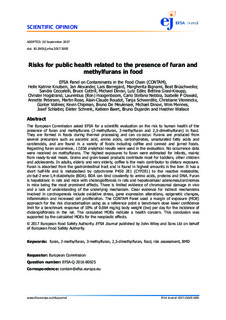| dc.contributor.author | Knutsen, Helle Katrine | |
| dc.contributor.author | Alexander, Jan | |
| dc.contributor.author | Barregård, Lars | |
| dc.contributor.author | Bignami, Margherita | |
| dc.contributor.author | Brüschweiler, Beat | |
| dc.contributor.author | Ceccatelli, Sandra | |
| dc.contributor.author | Cottrill, Bruce | |
| dc.contributor.author | Dinovi, Michael | |
| dc.contributor.author | Edler, Lutz | |
| dc.contributor.author | Grasl-Kraupp, Bettina | |
| dc.contributor.author | Hogstrand, Christer | |
| dc.contributor.author | Hoogenboom, Laurentius (Ron) | |
| dc.contributor.author | Nebbia, Carlo Stefano | |
| dc.contributor.author | Oswald, Isabelle P. | |
| dc.contributor.author | Petersen, Annette | |
| dc.contributor.author | Rose, Martin | |
| dc.contributor.author | Roudot, Alain-Claude | |
| dc.contributor.author | Schwerdtle, Tanja | |
| dc.contributor.author | Vleminckx, Christiane | |
| dc.contributor.author | Vollmer, Gunter | |
| dc.contributor.author | Chipman, Kevin | |
| dc.contributor.author | De Meulenaer, Bruno | |
| dc.contributor.author | Mennes, Wim | |
| dc.contributor.author | Schlatter, Josef | |
| dc.contributor.author | Schrenk, Dieter | |
| dc.contributor.author | Baert, Katleen | |
| dc.contributor.author | Dujardin, Bruno | |
| dc.contributor.author | Wallace, Heather | |
| dc.date.accessioned | 2018-06-28T12:26:50Z | |
| dc.date.available | 2018-06-28T12:26:50Z | |
| dc.date.created | 2018-03-19T10:10:37Z | |
| dc.date.issued | 2017 | |
| dc.identifier.citation | EFSA Journal. 2017, 15 (10), . | nb_NO |
| dc.identifier.issn | 1831-4732 | |
| dc.identifier.uri | http://hdl.handle.net/11250/2503622 | |
| dc.description.abstract | The European Commission asked EFSA for a scientific evaluation on the risk to human health of the presence of furan and methylfurans (2‐methylfuran, 3‐methylfuran and 2,5‐dimethylfuran) in food. They are formed in foods during thermal processing and can co‐occur. Furans are produced from several precursors such as ascorbic acid, amino acids, carbohydrates, unsaturated fatty acids and carotenoids, and are found in a variety of foods including coffee and canned and jarred foods. Regarding furan occurrence, 17,056 analytical results were used in the evaluation. No occurrence data were received on methylfurans. The highest exposures to furan were estimated for infants, mainly from ready‐to‐eat meals. Grains and grain‐based products contribute most for toddlers, other children and adolescents. In adults, elderly and very elderly, coffee is the main contributor to dietary exposure. Furan is absorbed from the gastrointestinal tract and is found in highest amounts in the liver. It has a short half‐life and is metabolised by cytochrome P450 2E1 (CYP2E1) to the reactive metabolite, cis‐but‐2‐ene‐1,4‐dialdehyde (BDA). BDA can bind covalently to amino acids, proteins and DNA. Furan is hepatotoxic in rats and mice with cholangiofibrosis in rats and hepatocellular adenomas/carcinomas in mice being the most prominent effects. There is limited evidence of chromosomal damage in vivo and a lack of understanding of the underlying mechanism. Clear evidence for indirect mechanisms involved in carcinogenesis include oxidative stress, gene expression alterations, epigenetic changes, inflammation and increased cell proliferation. The CONTAM Panel used a margin of exposure (MOE) approach for the risk characterisation using as a reference point a benchmark dose lower confidence limit for a benchmark response of 10% of 0.064 mg/kg body weight (bw) per day for the incidence of cholangiofibrosis in the rat. The calculated MOEs indicate a health concern. This conclusion was supported by the calculated MOEs for the neoplastic effects. | |
| dc.language.iso | eng | nb_NO |
| dc.relation.uri | https://efsa.onlinelibrary.wiley.com/doi/abs/10.2903/j.efsa.2017.5005 | |
| dc.rights | Attribution-NonCommercial-NoDerivatives 4.0 Internasjonal | * |
| dc.rights.uri | http://creativecommons.org/licenses/by-nc-nd/4.0/deed.no | * |
| dc.title | Risks for public health related to the presence of furan and methylfurans in food | nb_NO |
| dc.type | Journal article | nb_NO |
| dc.type | Peer reviewed | nb_NO |
| dc.description.version | publishedVersion | |
| dc.source.pagenumber | 142 | nb_NO |
| dc.source.volume | 15 | nb_NO |
| dc.source.journal | EFSA Journal | nb_NO |
| dc.source.issue | 10 | nb_NO |
| dc.identifier.cristin | 1573806 | |
| cristin.unitcode | 192,16,2,0 | |
| cristin.unitname | Institutt for mattrygghet og infeksjonsbiologi | |
| cristin.ispublished | true | |
| cristin.fulltext | original | |
| cristin.qualitycode | 1 | |

